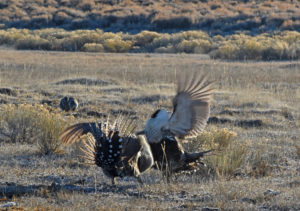Online Messenger #258
(view with pictures, as displayed in email)
The U.S. Fish and Wildlife Service announced that it is proposing to list the Bi-State sage-grouse population as Threatened under the Endangered Species Act and to designate 2,919 square miles of critical habitat.
The Bi-State sage-grouse is a geographically isolated, genetically distinct population of Greater sage-grouse. They occur on the California-Nevada border in the Mono Lake area, and are found in parts of Mono, Alpine, and Inyo Counties in California and in parts of Carson City, Douglas, Esmeralda, Lyon, and Mineral Counties in Nevada.
Major threats to the Bi-state sage-grouse population include livestock grazing and rangeland management, infrastructure including fences, power lines, roads, nonnative and native, invasive plants and altered fire regimes urbanization and habitat conversion, mining, renewable energy development, climate (including drought), and predation.
This proposal comes just a month after a federal court judge ruled that the Bureau of Land Management’s Bishop Field Office had failed to provide specific science about impacts to sage grouse nesting areas in its environmental review for four grazing allotments in the Bodie Hills. This ruling followed from an October 26, 2010 lawsuit filed by Western Watersheds Project challenging grazing decisions issued by the Field Office for the Bodie Mountain, Mono Sand Flat, Aurora Canyon, and Potato Peak grazing allotments in the Bodie Hills.
Without an ESA listing, the Fish and Wildlife Service expects that within 30 years it is likely that all the populations in Nevada will be extirpated and that only isolated populations in California’s Bodie Hills and Long Valley would remain.
No doubt we can expect vigorous challenges to the proposed listing from the livestock industry but Western Watersheds Project will continue to work to ensure that science prevails and that all populations of the iconic sage-grouse get the full protection they so clearly need.






